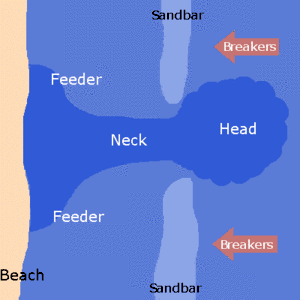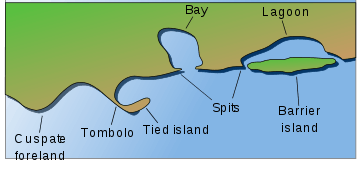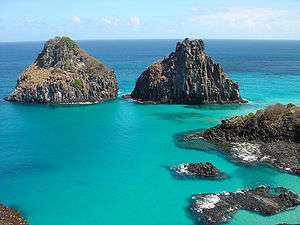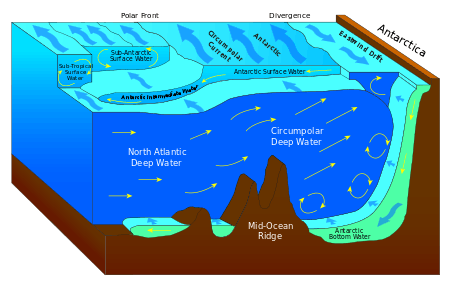Rip current
A rip current, often simply called a rip (or misleadingly a rip tide), is a specific kind of water current that can occur near beaches with breaking waves. A rip is a strong, localized, and narrow current of water which moves directly away from the shore, cutting through the lines of breaking waves like a river running out to sea. A rip current is strongest and fastest nearest the surface of the water.[1]

Rip currents can be hazardous to people in the water. Swimmers who are caught in a rip current and who do not understand what is happening, or who may not have the necessary water skills, may panic, or they may exhaust themselves by trying to swim directly against the flow of water. Because of these factors, rip currents are the leading cause of rescues by lifeguards at beaches, and are the cause of an average of 46 deaths by drowning per year in the United States.
A rip current is not the same thing as undertow, although some people use the term incorrectly when they are talking about a rip current. Contrary to popular belief, neither rip nor undertow can pull a person down and hold them under the water. A rip simply carries floating objects, including people, out to just beyond the zone of the breaking waves.
Causes and occurrence
A rip current forms because wind and breaking waves push surface water towards the land, and this causes a slight rise in the water level along the shore. This excess water will tend to flow back to the open water via the route of least resistance. When there is a local area which is slightly deeper, or a break in an offshore sand bar or reef, this can allow water to flow offshore more easily, and this will initiate a rip current through that gap.
Water that has been pushed up near the beach flows along the shore towards the outgoing rip as "feeder currents", and then the excess water flows out at a right angle to the beach, in a tight current called the "neck" of the rip. The "neck" is where the flow is most rapid. When the water in the rip current reaches outside of the lines of breaking waves, the flow disperses sideways, loses power, and dissipates in what is known as the "head" of the rip.
Rip currents can often occur on a gradually shelving shore where breaking waves approach the shore parallel to it, or where underwater topography encourages outflow at a specific area. Rip currents can form at the coasts of oceans, seas, and large lakes, whenever there are waves of sufficient energy. The location of rip currents can be difficult to predict; whereas some tend to recur always in the same places, others can appear and disappear suddenly at various locations along the beach. The appearance and disappearance of rip currents is dependent on the bottom topography and the exact direction that the surf and swells are coming in from.[2]
Rip currents can occur wherever there is strong longshore variability in wave breaking. This variability may be caused by such features as sandbars (as shown in the animated diagram), by piers and jetties, and even by crossing wave trains, and are often located in places such as where there is a gap in a reef or low area on a sandbar. Rip currents may deepen the channel through a sandbar once they have formed.
Rip currents are usually quite narrow, but tend to be more common, wider, and faster, when and where breaking waves are large and powerful. Local underwater topography makes some beaches more likely to have rip currents; a few beaches are notorious in this respect.[3]
Although rip tide is a misnomer, in areas of significant tidal range, rip currents may only occur at certain stages of the tide, when the water is shallow enough to cause the waves to break over a sand bar, but deep enough for the broken wave to flow over the bar. (In parts of the world with a big difference between high tide and low tide, and where the shoreline shelves gently, the distance between a bar and the shoreline may vary from a few meters to a kilometer or more, depending whether it is high tide or low tide.)
A fairly common misconception is that rip currents can pull a swimmer down, under the surface of the water. This is not true, and in reality a rip current is strongest close to the surface, as the flow near the bottom is slowed by friction.
The surface of a rip current may appear to be a relatively smooth area of water, without any breaking waves, and this deceptive appearance may cause some beach goers to believe it is a suitable place to enter the water.[4]
Technical description
A more detailed and technical description of rip currents requires understanding the concept of radiation stress. Radiation stress is the force (or momentum flux) that is exerted on the water column by the presence of the wave. When a wave reaches shallow water and shoals, it increases in height prior to breaking. During this increase in height, radiation stress increases, because of the force exerted by the weight of the water that has been pushed upwards. To balance this, the local mean surface level drops; this is known as the setdown. When the wave breaks and starts reducing in height, the radiation stress decreases as the amount of water that is elevated decreases. When this happens, the mean surface increases — this is known as the setup.
In the formation of a rip current, a wave propagates over a sandbar with a gap in it. When this happens (as shown in the second image in this article), most of the wave breaks on the sandbar, leading to "setup". However, the part of the wave that propagates over the gap does not break, and thus the "setdown" continues in that part. Because of this phenomenon, the mean water surface over the rest of the sandbar is higher than that which is over the gap, and the result is that a strong flow issues outward through the gap. This strong flow is the rip current.
Visible characteristics

Rip currents have a characteristic appearance, and, with some experience, they can be visually identified from the shore before entering the water. This is useful to lifeguards, swimmers, surfers, boaters, divers and other water users, who may need to avoid a rip, or in some cases make use of the flow.
Rip currents often look somewhat like a road or river running straight out to sea, and they are easiest to notice and identify when the zone of breaking waves is viewed from a high vantage point. The following are some visual characteristics that can be used to identify a rip:[5]
- A noticeable break in the pattern of the waves — the water often looks flat at the rip, in contrast to the lines of breaking waves on either side of the rip.
- A "river" of foam — the surface of the rip sometimes looks foamy, because the current is carrying foam from the surf out to open water.
- Different color — the rip may differ in color from the surrounding water; it is often more opaque, cloudier, or muddier, and so, depending on the angle of the sun, the rip may show as darker or lighter than the surrounding water.
- It is sometimes possible to see that foam or floating debris on the surface of the rip is moving out, away from the shore. In contrast, in the surrounding areas of breaking waves floating objects and foam are being pushed towards the shore.
These characteristics are helpful in learning to recognize and understand the nature of rip currents. Learning these signs can enable a person to recognize the presence and position of rips before entering the water.
In the United States, some beaches have signs created by the National Oceanic and Atmospheric Administration (NOAA) and United States Lifesaving Association, explaining what a rip current is and how to escape one. These signs are titled, "Rip Currents; Break the Grip of the Rip".[6] Two of these signs are shown in the image at the top of this article. Beachgoers can also get information from lifeguards, who are always watching for rip currents, and who will move their safety flags so that swimmers can avoid rips.
Danger to swimmers


Rip currents are a potential source of danger for people in shallow water with breaking waves, whether this is in seas, oceans or lakes.[5] Rip currents are the proximate cause of 80% of rescues carried out by beach lifeguards.[7]
Rip currents typically flow at about 0.5 m/s (1.6 ft/s), but they can be as fast as 2.5 m/s (8.2 ft/s), which is faster than any human can swim. However, most rip currents are fairly narrow, and even the widest rip currents are not very wide; usually swimmers can exit the rip easily by swimming at a right angle to the flow, parallel to the beach. But swimmers who are unaware of this fact may exhaust themselves trying unsuccessfully to swim against the flow.[2] The flow of the current also fades out completely at the head of the rip, outside the zone of the breaking waves, so there is a definite limit to how far the swimmer will be taken out to sea by the flow of a rip current.
In a rip current, death by drowning occurs when a person has limited water skills and panics, or when a swimmer persists in trying to swim to shore against a strong rip current, thus eventually becomes exhausted and drowns.
According to NOAA, over a 10-year average, rip currents cause 46 deaths annually in the United States, and 64 people died in rip currents in 2013.[8] However, the United States Lifesaving Association "estimates that the annual number of deaths due to rip currents on our nation's beaches exceeds 100."[6]
A study published in 2013 in Australia revealed that rips killed more people on Australian territory than bushfires, floods, cyclones and shark attacks combined.[9]
Management
People caught in a rip current may notice that they are moving away from the shore quite rapidly. Often, it is not possible to swim directly back to shore against a rip current, so this is not recommended. Contrary to popular misunderstanding, a rip does not pull a swimmer under the water, it simply carries the swimmer away from the shore in a narrow band of moving water.[1]
A rip current is like a moving treadmill, which the swimmer can get out of quite easily by swimming at a right angle across the current, i.e. parallel to the shore in either direction. Rip currents are usually not very wide, so getting out of one only takes a few strokes. Once out of the rip current, getting back to shore is also not difficult, since waves are breaking, and floating objects (including swimmers) will be pushed by the waves towards the shore.[10]
As an alternative, people who are caught in a strong rip can simply relax and go with the flow (either floating or treading water) until the rip current dissipates completely once it is beyond the surf line. Then the person can signal for help, or swim back through the surf, doing so diagonally, away from the rip and towards the shore.[2]
It is necessary for coastal swimmers not only to understand the danger of rip currents, but to learn how to recognize them, and how to deal with them. And whenever possible, people should swim only in areas where lifeguards are on duty.[5]
Uses
Experienced and knowledgeable water users, including surfers, body boarders, divers, surf lifesavers and kayakers, when they wish to get out beyond the breaking waves, will sometimes use a rip current as a rapid and effortless means of transportation.[11]
See also
- Cross sea
- Longshore drift
- Rip current statement — warnings issued by the U.S. National Weather Service
- Undertow (water waves)
References
- "Rip Current Characteristics". College of Earth, Ocean, and Environment, University of Delaware. Retrieved 16 January 2009.
- "Rip Currents". United States Lifesaving Association. Retrieved 8 July 2009.
- "Rip currents at Ocean Beach are severe hazard for unwary, UC Berkeley expert warns". University of California, Berkeley. 23 May 2002. Retrieved 10 January 2018.
- Don't get sucked in by the rip... on YouTube
- "Rip Currents Safety". U.S. National Weather Service. Retrieved 16 January 2009.
- "NOAA Reminds Swimmers That Rip Currents Can Be a Threat. Rip Current Awareness Week Is June 1–7, 2008" (Press release). National Oceanic and Atmospheric Administration. 2 June 2008. Retrieved 16 July 2014.
- "NWS Rip Current Safety Home Page". U.S. National Weather Service. Retrieved 10 January 2018.
- "NWS Weather Fatality, Injury and Damage Statistics". NOAA. 25 April 2018.
- "Rips more deadly than bushfires and sharks". Australian Geographic. Retrieved 27 November 2013.
- "Beach and Surf Safety". Science of the Surf. Retrieved 10 January 2018.
- Cowan, C. L. "Ride the Rip". Paddling.com. Archived from the original on 17 August 2017. Retrieved 12 July 2018.
External links
![]()



